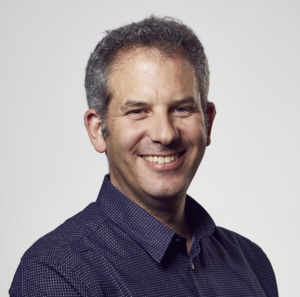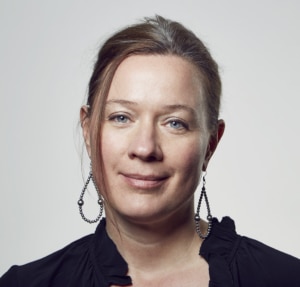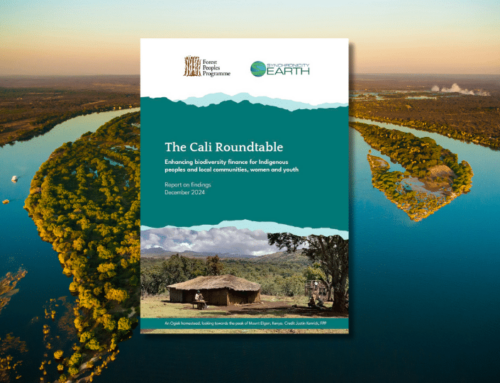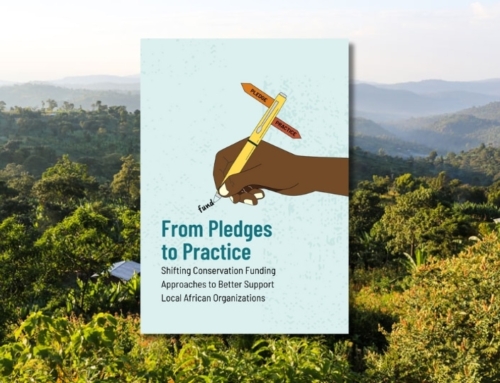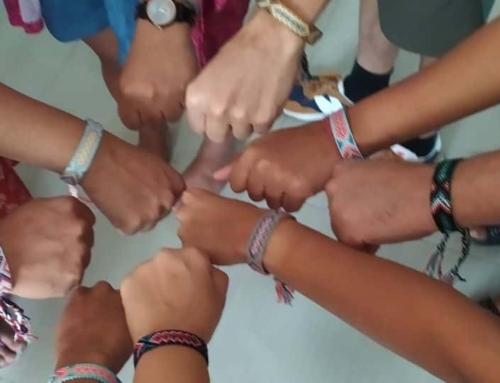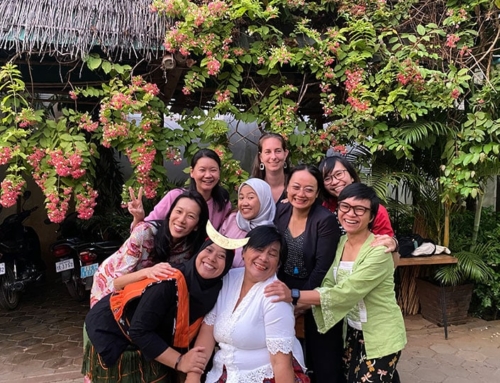As Synchronicity Earth celebrates 15 years since it was founded, Nina Seale speaks to our Co-Founders, Adam and Jessica Sweidan, about the lessons and surprises from the journey so far, and what will be most important going forward.
The lightbulb moment
You and Adam were working on the Synchronicity Foundation, which was supporting a wide range of projects for a while before Synchronicity Earth was created. What caused the shift to an environmental focus?
Jessica: There was a week in the summer of 2007 where two things happened. First, we learned that the Zoological Society of London’s launch of the Evolutionarily Distinct & Globally Endangered (EDGE) of Existence project in 2007 raised a mere £50,000. Later that week, we attended the opening of Damien Hirst’s famous exhibition at the White Cube Gallery and Eternity, one of the ‘Kaleidoscope’ paintings with over 2,700 butterflies sold for £4,700,000. That was almost 10 million dollars, and today would be the equivalent of over 11 million pounds.
It was a violent realisation, especially for Adam, about the value system of our culture.
Our society was placing far more value on artistically represented dead butterflies, than the possibility of preventing the 100 most threatened, unique species on earth from going extinct.
For me, it signalled the power of art as a medium in shifting perceptions, and informing culture, whether positively or negatively.
Within the same week, I had an epiphany sparked by a BBC programme. It showed an orang-utan in the last tree standing of a clearcut forest, waiting to be saved – by being darted and taken to a refuge – so the bulldozer waiting on the side could do its deed. After viewing that footage, everything changed. The kernel of what would become Synchronicity Earth was formed. Within minutes of my response to that footage, we immediately decided to shift our total philanthropic focus to the biodiversity crisis.

Jessica has always felt an affinity for orang-utans, and one of Synchronicity Earth’s long-term partners is HUTAN, which conserves and restores forests in Malaysian Borneo, home to these iconic primates and many other species. © HUTAN
Adam: The environmental theme was there all along, though. All the individual causes and projects we were supporting before Synchronicity Earth, across the board – from health and education to supporting refugees and human-elephant conflict – everything connected to the environment. Everything is affected by it.
I do think that this massive extinction crisis is the moral issue of our time. If you want to think of it in terms of the United Nations development goals, the cake diagram by Johan Rockström shows it really well.
Without clean water, without climate action, without life on land and underwater, there aren’t functioning systems. So nothing else matters.
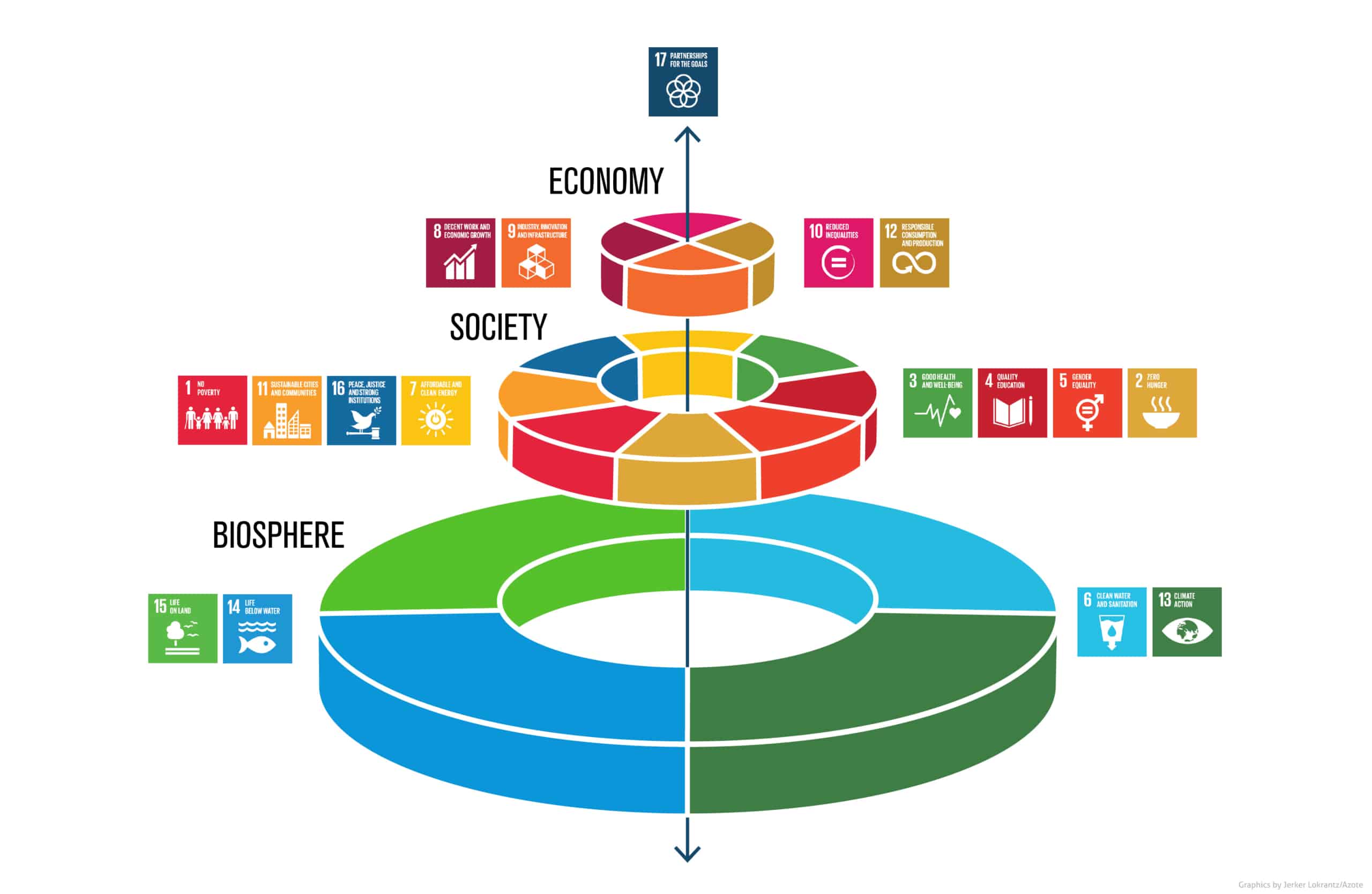
Stockholm Resilience Centre Director Johan Rockström and board member Pavan Sukhdev integrates the global sustainable goals to show how foundational the environmental goals are to upholding everything else. Image: Azote Images for Stockholm Resilience Centre
The gaps: overlooked and underfunded
Synchronicity Earth’s focus which, given the many issues that fall under the biodiversity crisis, is quite distinct. How did you decide on the direction of Synchronicity Earth?
Adam: Like many people, when we started, we were led by our hearts. My love for nature is intrinsic to me, so my heart and emotions were there before my intellect, but when my brain understood that biodiversity loss is an existential threat to humanity, a penny dropped. We created Synchronicity Earth to be scientifically based and systematic; we wanted to optimise our impact. Our first staff member began by mapping global philanthropic funding flows against key areas of biodiversity which would ultimately inform where we would start: in the gaps.
The ‘gaps’ focus later defined us: ‘overlooked and underfunded’. That is how our programmes developed. At one point there were more tiger organisations than tigers in the wild. Meanwhile, nearly a quarter of the ~15,000 freshwater fish species we have are threatened with extinction, and 158 million people rely on freshwater fish for their protein. Yet, before SHOAL was founded, there wasn’t a single organisation focused on the thousands of species of freshwater fish in the world.
I’m really proud of how the programmes have developed. When we started Synchronicity Earth we had forest, ocean, species, and freshwater programmes. The forest programme evolved into the Congo Basin Programme, which has been an amazing success.
In our ocean work… we went all in on the high and deep seas, when it was a gap. Our partners were a huge part of the victory in the United Nations, finally getting a High Seas Treaty agreed after decades of work. Now the Ocean Programme has broadened to include other overlooked areas, species like sawfish and habitats like seagrass.
I just love the way the programmes continue to evolve and grow. They are like these living entities unto themselves.

A historic achievement for our high seas partners: When the United Nations high seas treaty was finally agreed, the President of the high seas treaty process, Rena Lee, received a standing ovation. © IISD ENB Mike Muzurakis
A huge component of our programmes is prioritising locally-led partners. What about the local approach do you think is so important for conservation?
Adam: It is a little worrying, the way that the conservation sector is so focused on the macro. I mean that with regard to the conversations which have just come out of COP16, the United Nations Convention on Biological Diversity conference which just took place in Cali, Colombia. Everyone is talking about big landscapes, these huge changes to development, and biodiversity offsets, which might make sense from a distance but if you’re the frog that’s going to go extinct because they are building a bauxite mine in your only forest, the fact those companies are going to offset their impact somewhere else is not very helpful.
I also think the macro view can be very overwhelming and depressing. But when you look on the micro side, it is very empowering, because you can make a big difference on a small level.
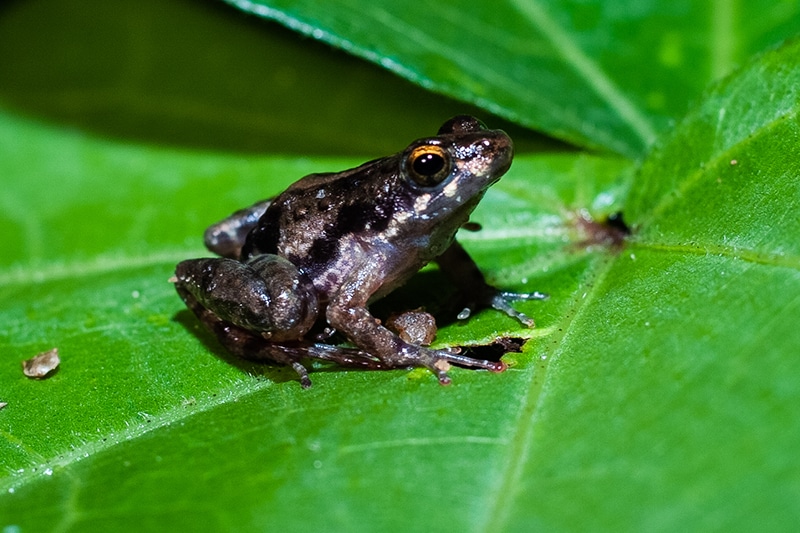
Afia Birago’s puddle frog is a new species described in the Atewa Forest. It is Critically Endangered due to an impending mining threat, but our partner Herp Conservation Ghana has been campaigning for the protection of this habitat. © Michael Akrasi
Jessica: Local voices are everything, and they need to be centred. We can’t compete with their knowledge, we just can’t. There is finally some recognition of this – in Cali at COP16 the United Nations Convention on Biological Diversity (UN CBD) have just created a subsidiary body for Indigenous Peoples to be involved with conservation decision making, which is long-overdue recognition of the knowledge and stewardship these people have and how crucial they are to conservation. We want to continue to help amplify their voices on these large global stages.
It’s the same for young people – we co-hosted four youth events at COP16 and I spent a lot of time with the Global Youth Biodiversity Network, who are exceptional, absolutely brilliant.
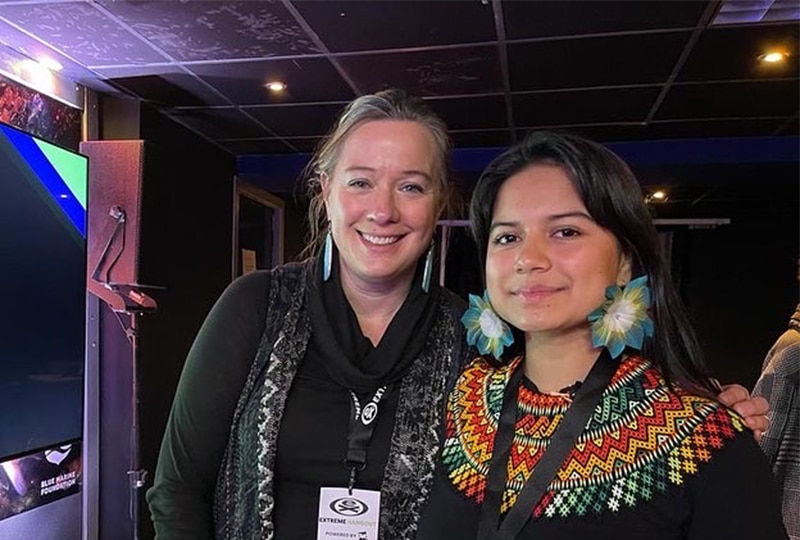
Jessica at COP16 with Helena Gualinga, an Ecuadorian human rights activist whose fellowship with New York University’s Climate Litigation Accelerator Programme is supported by the Freshwater Programme. © Jessica Sweidan
Turning abstract hope into action
This recent recognition of Indigenous Peoples at the UN CBD indicates that more international bodies and funders are recognising the importance of locally-led approaches. With more organisations funding locally led work, what value-add do you think Synchronicity Earth can offer?
Jessica: For me it is about the how we are doing this work that is critical to the long-term success we all want to see. We can apply approaches and send funds and support conservation, but I believe that the way in which we do that is key – it is all about relational accountability. Our team put the time in and hold beautiful relationships – we call our grantees partners for a reason. We call our funders partners for a reason too.
We are all in this together, working as a functional ecosystem, each contributing to the whole.
If we want to regenerate an ecosystem, and empower our partners to do so, then we need to mirror what is needed in situ in the way that we work ex situ. And that requires communication, flexibility, understanding, and trust – all qualities that take time to establish. I’m most proud of our community, both internally and externally. I think we have an incredible team who hold up these values. So, for me, the inherent relationality of our model, and the mechanisms we have embedded for long-term support are what makes us extra special.
Adam: There is inherent complexity in doing this work well, and through our endowment funds and pooled funds, we offer other funders a collaborative way of saving time on the delicate balance of due diligence and deeply held relationships while still being able to give, and give well (with flexible, long-term, and sustainable funding) to support an incredible tapestry of remarkably devoted people who are helping their communities and the species they are advocating for.

Jessica and Xiye Bastida at the launch of the Chrysalis Youth Fund during New York Climate Week 2023. © Leandro Justen
Giving better: reimagining philanthropy
What do you mean by flexibility when you’re talking about environmental philanthropy?
Jessica: Funding isn’t just funding. Depending on how you fund, what you’re giving can become more valuable to the organisations on the ground and the impact can be so much greater.
I was recently in New York for Climate Week and attended an event where I saw some of our Congo Basin partners: Joseph Itongwa (Regional Coordinator for Central Africa, ICCA Consortium), Patrick Saidi Hemedi (National Coordinator of the Dynamique des Groupes des Peuples Autochtones (DGPA)) and our Advisor, Samuel Nnah Ndobe. The Congo Basin is finally being understood as a critical ecosystem in need of much more support and is now receiving hundreds of millions through large philanthropic programmes, far beyond our grant sizes. As I was sitting there listening to these incredible funding announcements, I wondered what role do we still play?
So, I asked: “Now that you’ve got all of these big commitments coming in, is our funding still valuable to you?” They answered without hesitation: “It is absolutely crucial.” The big funding is wonderful and so important – it will help with large scale regional initiatives, but they said, “Synchronicity Earth’s funding is priceless” — it supports core costs, enabling them to address very local issues as they arise.
Of course I know this, but sometimes it is important to ask. I know our long-term support makes a difference: a few years ago, after years of effort, Dynamique des Groupes des Peuples Autochtones (DGPA), was instrumental in creating the new law in the Democratic Republic of Congo recognising the rights of the Indigenous Pygmy Peoples.
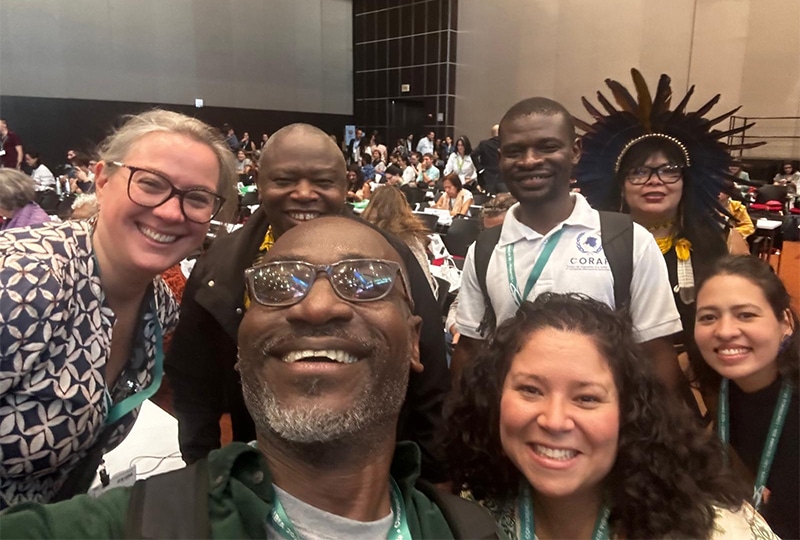
Some of the Synchronicity Earth team and friends together at COP16 with (top, left to right) Jessica Sweidan, Joseph Itongwa, Emmanuel Musuyu, Juliana Kerexu, (below, left to right), Samuel Nnah Ndobe, Grace Souza, and Gabriela Pires. © Samuel Nnah Ndobe
After all these years, you’ve had many experiences, what have you learned from Synchronicity Earth?
Jessica: Synchronicity Earth has given me phenomenal exposure to so much knowledge, wisdom, insight and teaching. I am inspired by the clarity and vibrancy of the young people that we work alongside, across our programmes and through the Chrysalis Youth Fund.
Through the tapestry of partners, elders, and allies – my way of understanding the world has been forever altered.
I have learned so much about resilience and how to source joy, even at the darkest moments. I have also been lucky to visit many of the places and territories that our partners live and work in, witnessing so much beauty, and devastation in equal measure – our partners hold a lot. Through these tangible experiences I have come to understand what rolling up your sleeves and doing the work means. It is and must be a daily practice.
Adam: My learning has been on a deep philosophical and a practical level. On a practical level, I realise the lens I gather information from consists of a combination of curated material from news outlets and social media, and what the world wants me to see and what affects the markets. The news on climate change tends to be through the lens of economic impact, not human suffering. From our partners, I get a much more nuanced and broader view – things are happening to them that I would otherwise not know about.
Our partners are working in 34 countries; learning about their specific challenges and their geopolitical realities has provided a front row seat to watching the ecological breakdown.
On a philosophical level, being able to spend two weeks in the Ecuadorian Amazon with our partners from the Amazon Sacred Headwaters Alliance (ASHA) finally made me understand what Indigenous people mean when they say, ‘we are nature.’ It’s interesting, hearing that the theme at COP16 was ‘Peace with Nature’, I have realised the war against nature is not only a war that we cannot win, but it is a war against ourselves.
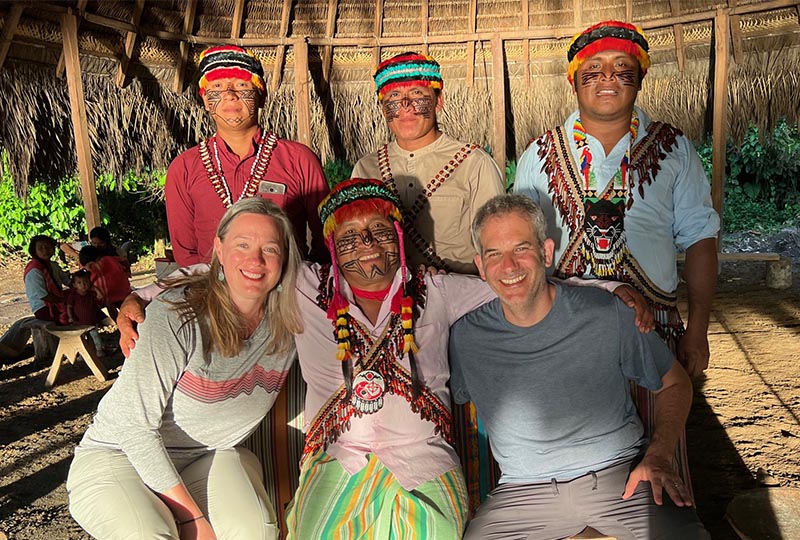
Jessica and Adam visited the Ecuadorian Amazon to meet with our partners from the Amazon Sacred Headwaters Alliance (ASHA). © Jessica Sweidan
Onwards…!
So, what is next for Synchronicity Earth?
Adam: We want to scale up what we are doing. We won’t stop learning, we are always continuously adapting and improving and evolving, but we currently have capacity to scale up what we are doing substantively without compromising our integrity or degrading our impact. We’ve spent fifteen years developing our approach, designing dynamic, important and thoughtful programmes based on a lot of learning and experience. We have been building our team and have an exceptional network of affiliates, advisors and allies. I really feel like we have something amazing to offer.
Thinking about how future generations will see us… we are in a critical period of history. If this was a play about this extinction crisis, we can’t necessarily predict how the play is going to end, but we can choose our roles.
You get to decide what impact you will have, you get to choose because we are alive in this moment of time when we really can change the future.
Synchronicity Earth is a value-led organisation inspired by the vision of a world in which biological and cultural diversity are valued, celebrated, and flourishing.
We bring conservation to life through our work, championing effective approaches and increasing funding for Earth’s overlooked species and ecosystems and the communities working to protect them.
Explore our website to learn more about our team, our partners, our strategy, and our programmes. If you are interested in working with us to support our partners, please get in touch.


